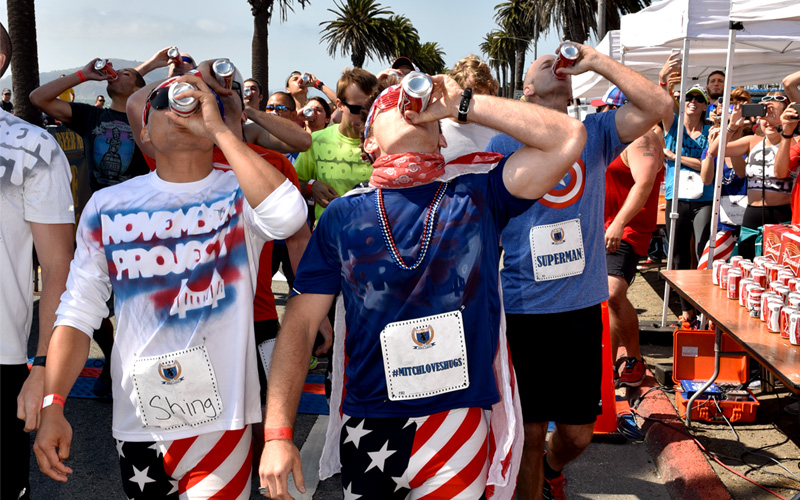
The beer mile is the ultimate feat of athleticism and drinking prowess. It takes a certain type of person to finish four laps on a track and down a beer at each quarter mile — the rare breed of person who is as skilled at running as keeping down beer.
Today there are world championships, a heavily trafficked beer mile forum and a National Beer Mile organization. But not so long ago there were just seven Canadian guys with a penchant for competitive drinking and running. Probably.
Runners World wrote an extensive and in-depth history of the beer mile back in 2014 in a story called “The Untold History of the Beer Mile.” In that account, the first beer mile was on a warm August night in 1989 on the Burlington Central High School track in Burlington, Ontario. The youngest participant was Graham Hood, who was 17 at the time and later competed in the Olympics in the 1,500-meter race. The oldest was Kelly Harris, who was 26 at the time. You had to be 19 to drink in Canada in 1989, hence the after-hours time slot.
A few years later, two of the runners, Ian Fallas and Rob Auld, brought the tradition with them to Queen’s University in Kingston, Ontario. Beer mile competitions spread by word of mouth and, by 1993, an official set of rules was set down. Those rules were thenceforth known as the Official Kingston Rules.
They were as such: The alcohol content must be over 5 percent, it must be drunk out of a can, four beers must be drunk (women only drink three), an extra lap is added on if you puke and absolutely no drinking aids can be used.
Then the United States got involved. A guy named Patrick Butler at Wesleyan University in Connecticut bought the domain name beermile.com in 1998 and started keeping track of U.S. running times with the Kingston Rules (minus the rule that women only have to drink three). The beer mile was never the same.
James Nielsen, a collegiate runner, started to train for the beer mile like a professional. One part of his training was mile training, the second part of his training was Takeru Kobayashi-style stomach stretching. He broke the five-minute mile for the first time in 2014, and with it he broke the beer-mile internet. The beer mile has been common college-room knowledge ever since.
The official beer mile website, however, doesn’t get quite so specific. Instead, it states that the beer mile is an invention “not dissimilar to the invention of calculus,” and that multiple parties are responsible for the beer mile. It also states that colleges in Florida and New England started it, not underage drinkers in Canada.
Regardless of the beer mile’s origin story, there are now more than 100,000 entries and over 7,000 recorded races on beermile.com.
There are also plenty of variations. There’s the Rubik’s Cube Mile (solve a Rubik’s Cube every quarter mile in addition to the beer) and the Ben and Jerry’s 4×4 (four pints of Ben and Jerry’s for four miles). For the true believers, though, there’s the Bicentennial, which is 100 beers in 100 miles over the course of a week.
Stephanie Stark, the current social media editor for New York Governor Andrew Cuomo, is one of the most well-documented people to complete the Bicentennial. She ran it with two of her male friends, though she ran the 120-pound equivalent — 70 beers instead of 100. But when’s the last time you were 120 pounds and drank 100 beers in seven days?
She gave her advice for completing it to the blog Writing About Running: Ice bath every day, two-a-day runs and “don’t do it with anyone you would be embarrassed to shit yourself in front of, just in case.”
That’s some Tony Stark-level perseverance.
Alas, we can’t all be Stephanie Stark. The regular beer mile is challenge enough. Here are the official rules, via the official beer mile resource.
The Official Beer Mile Rules
1. You must drink four cans of beer and run four laps on a track. Drink one beer to start, and then one beer every time you finish a lap.
2. The beer must be finished before the lap starts. You have the 10-meter transition zone to get it all down.
3. The first beer must be finished in the last meter of the transition zone to make sure that everyone does a complete mile.
4. Women do indeed drink the full four beers.
5. Beers must be canned or bottled 12-ounce beers.
6. No wide mouth bottles or ridiculous flow cans that offer an advantage.
7. No shotgunning or puncturing the can except from the tab to open it.
8. Beer must be at least 5 percent alcohol by volume. No hard ciders, lemonades or sodas.
9. The beer cannot be opened until the runner reaches the transition zone.
10. A penalty lap is added onto the end of the fourth lap for any competitor that vomits. One lap, regardless of how many vomits.
**BONUS** Turn the can over your head when done to prove it is empty.
